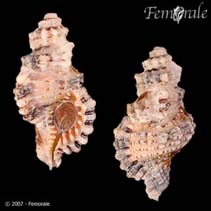Cymatium nicobaricum (Roding, 1798)
Nicobar hairy triton| Native range | All suitable habitat | Point map | Year 2050 |

|
| This map was computer-generated and has not yet been reviewed. |
| Cymatium nicobaricum AquaMaps Data sources: GBIF OBIS |
Classification / Names Common names | Synonyms | CoL | ITIS | WoRMS
Gastropoda | Littorinimorpha | Ranellidae | Cymatiinae
Environment: milieu / climate zone / depth range / distribution range Ecology
Benthic; depth range 0 - 100 m (Ref. 349). Tropical; 32°N - 16°S, 97°E - 6°E (Ref. 83435)
Distribution Countries | FAO areas | Ecosystems | Occurrences | Introductions
Indo-Pacific and Atlantic Ocean.
Length at first maturity / Size / Weight / Age
Maturity: Lm ? range ? - ? cm Max length : 9.0 cm SHL male/unsexed; (Ref. 349); common length : 6.5 cm SHL male/unsexed; (Ref. 349)
Locally collected by hand, where common, by native people of the Pacific islands (Ref. 349). Most common between tide marks and in shallow subtidal waves. Inhabits dead coral blocks (Ref. 799). Also found in shelf zones (Ref. 349), outer edges of windward reef flats (Ref. 69146), intertidal coral reefs, reef and coastal lagoons, particularly on algae, boulder, coral, rock, sand and shell habitats (Ref. 83934). Also on seagrass and offshore banks (Ref. 109264).
Life cycle and mating behavior Maturity | Reproduction | Spawning | Eggs | Fecundity | Larvae
Members of the order Neotaenioglossa are mostly gonochoric and broadcast spawners. Life cycle: Embryos develop into planktonic trocophore larvae and later into juvenile veligers before becoming fully grown adults.
Main reference
References | Coordinator | Collaborators
Poutiers, J.M. 1998. (Ref. 349)
IUCN Red List Status (Ref. 130435)
CITES status (Ref. 108899)
Not Evaluated
CMS (Ref. 116361)
Not Evaluated
Threat to humans
Human uses
| FishSource |
Tools
More information
Internet sources
Alien/Invasive Species database | BHL | BOLD Systems | CISTI | DiscoverLife | FAO(Publication : search) | Fishipedia | GenBank (genome, nucleotide) | GloBI | Gomexsi | Google Books | Google Scholar | Google | PubMed | Tree of Life | Wikipedia (Go, Search) | Zoological Record
Estimates based on models
Preferred temperature
(Ref. 115969): 23.7 - 29.1, mean 28 (based on 2060 cells).
Price category
(Ref. 80766):
Unknown.



